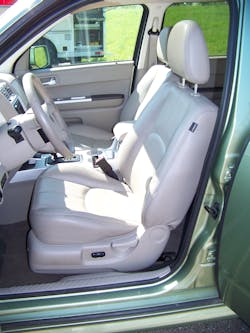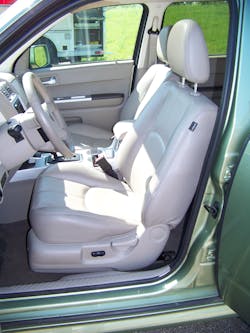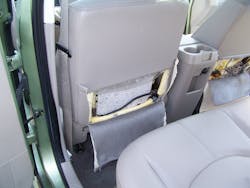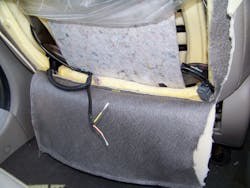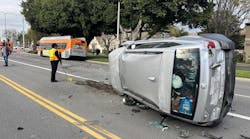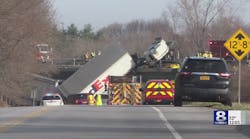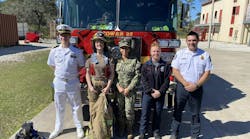Topic: Understanding seat-mounted, side-impact airbag systems
Objective: The rescue team company officer and vehicle rescue instructors shall understand the process for intentional deployment of seat-mounted side impact airbags.
Task: The rescue team vehicle rescue instructor shall understand the process for airbag ‘Hot-Wiring’ (intentional deployment of seat-mounted side impact airbags) for training and educational purposes.
As a vehicle rescue instructor, this author does not allow extrication training to take place on an acquired vehicle that still has undeployed supplemental restraint airbags—frontal, seat or door-mounted, kneebags, or roofbags. Accidental airbag deployment is a known risk for responders at real-world incidents and a well-known possibility at planned training events such as a company-level vehicle rescue session.
If a deployment occurred during extrication training and a member were injured, it would essentially be impossible for an instructor or company officer to say that they were not aware of this risk. Without “hot-wiring” the undeployed bags and firing them off at the start of the class prior to cutting up the vehicle, it would be difficult for an officer or instructor to validate that they were not aware of this risk and that they had properly prepared for this possibility.
This University of Extrication article provides a special look at what is referred to as the process of airbag “hot-wiring” with our focus on side-impact, seat-mounted airbag systems. We will walk through the few basic steps that an extrication instructor or company rescue officer can take prior to the class showing up to prepare these airbags for intentional deployment at the start of the vehicle rescue training session.
Airbag IDs
Seat-mounted airbags are relatively small and are designed to be modular with their stored gas inflator and the airbag itself all contained within one unit.The most common seatbag unit is mounted on the exterior outboard frame of the seatback. The presence of the seatbag may be identified by an airbag ID, which is most likely a shirt tag-style piece of cloth sewn into the upholstery of the seatback cushion itself. Airbag IDs can also be decals on the frame of the seat or raised letters somewhere along the seat hinge area. Look all around the seat structure for IDs because if one or two are present, you have undeployed seatbags to deal with.
There is the possibility of a second seatbag being under the seat cushion, making for two seatbags on just one seat, so also check for this. Center seat airbags, either for the driver’s seat or between the rear seats, will also have a second bag and a second inflator, so be on the lookout for this possibility as well.
Setting up for deployment
Once the presence of an undeployed seatbag has been detected, the instructor should take a sharp knife and gently cut away the rear upholstery, low along the back side of the seatback. With the trim opened and maybe foam or cushion stuffing removed, it may be possible to see the small, thin-gauge pair of wires that provide electrical power to the stored gas inflator of the airbag unit.With the airbag wires identified, this wire is cut and spliced to expose bare ends of the two thin wires. A length of standard household electrical extension cord is then spliced into each airbag wire, leaving the end of the extension cord six to eight feet outside of the acquired vehicle.
When the participants in the rescue class show up for the training, the instructor can introduce the issue of undeployed airbags in a crash-damaged vehicle and explain that a deployment demonstration has been set up on this training vehicle allowing intentional deployment of the airbags—specifically the seatbags.
After opening both front doors so participants can get the best view of the deployment, and explaining where the seatbag inflation zone is, the instructor should position themself in a safe area away from the seatbag so all participants can observe the deployment. Using a power source such as a 9-volt smoke alarm battery, the instructor can touch the terminals of the small battery to the ends of the extension cord causing the seatbag to immediately deploy.Educational and responsible
Airbag hot-wiring can be a difficult task, especially when the donated vehicle that your crew is going to cut up is loaded with airbags that are undeployed. As a company rescue officer or a vehicle rescue instructor, we must make the effort to identify undeployed frontal, kneebags, seatbags, doorbags, and roofbags and deploy them with the participants present as part of the class.Besides reducing the safety risk to rescue participants, airbag deployments are a great educational experience, one that will impress responders and emergency medical personnel by showing them a violent event their patients have experienced prior to their arrival.
If a participant is injured by an undeployed airbag firing off during extrication training, you as company officer (responsible adult) and especially you as a vehicle rescue instructor, will be involved in the civil litigation that follows whether you want to be or not!
